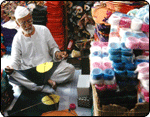Culture
 Lucknow', this name is synonymous with architectural beauties of 'Lakhauri' bricks, the fragrance of 'itra', musical notes, the sound of dancers' trinklets, the sweetness of 'dussheri' mangoes, 'malai' and 'gulab revadis', and of course its 'Mehman Nawazi'. Known for its refinement in speech, entertainment, dresses and manners, Lucknow is also called the 'City of Adab'. Infact, it is here that one can experience hospitality in the true sense of the term. Various cultural ingredients have contributed to the richness of this unique city. Mention must be made of the Urdu language. Gazals, Shairi, expressive dance forms, colourful festivals, buzzing chowks and various exciting games like Patangbazi, Baterbazi & Kabutarbazi.
Lucknow', this name is synonymous with architectural beauties of 'Lakhauri' bricks, the fragrance of 'itra', musical notes, the sound of dancers' trinklets, the sweetness of 'dussheri' mangoes, 'malai' and 'gulab revadis', and of course its 'Mehman Nawazi'. Known for its refinement in speech, entertainment, dresses and manners, Lucknow is also called the 'City of Adab'. Infact, it is here that one can experience hospitality in the true sense of the term. Various cultural ingredients have contributed to the richness of this unique city. Mention must be made of the Urdu language. Gazals, Shairi, expressive dance forms, colourful festivals, buzzing chowks and various exciting games like Patangbazi, Baterbazi & Kabutarbazi.
Lucknow became the focal point of a cultural renaissance with theshifting of capital from Faizabad to Lucknow in 1776. Under royal patronage Kathak, Thumri, Khayal, Dadra, Gazals, Qawalies and Sher-o-Shairi reached their zenith point. As a centre of Islamic learning Lucknow witnessed the formation of Lucknow school of poetry under renowned poets like Anes, Dabeer, Imam-Buksh 'Nasika', Mirza Mohd. Raza Khan Burq, Atish, Mirza Shauq Asar, Josh and others. Apart from Gazals, another form of long narrative poem for which Lucknow is famous is Masnavi. Elegy writing in Urdu also reached a new height through the three forms-'marsiyas'*. 'salams'* and 'nauhas'*. Urdu as a language attained a rare degree of perfection in Lucknow and slowly Lucknow emerged as a cradle of unforgettable gazals, masnavi, elegy, hazal* and dramas. Nawab Wajid Ali Shah, himself composed a number of songs and dramas under the pen name of , 'Akhtari Pia'. Of the famous Indian dance styles kathak is closely associated with Lucknow.
This devotional dance stvle of pre-Mughal days was transformed into a highly eclectic dance form under the patronage of the Nawabs of Awadh. Pandit Iswari Prasad Mishra of Handia is said to be the founder of the Lucknow gharana of Kathak. The Kathak school founded by him was perfected by his sons Thakur Prasad, Durga Parsad. Bindadin. Kalka Prasad and the three sons of Kalka-Achchhan Maharaj, Lachchu Maharaj and Shambhu Maharaj. Today Pandit Birju Maharaj is the living doyen of this glorious house of Lucknow Turning to the festivals that make, Lucknow one-of-a-kind, mention must be made to the Moharrum festival.
Commemorating the death of Imam Hussain, Moharrum witnesses emotional processions of tazias (models of Imam Hussain's mausoleum at Karbala, Iraq) & Alam's. Not only festivals, the people of this beautiful city 'indulge in various exciting contests that have come down from the time of the Nawabs. Kite flying is one such sport. Kites of different shapes, sizes, colours take to the skies leading to all round excitement and enjoyment The art of training pigeons which was perfected by the nobility of yesteryears is prevalent even today. The pigeon flying event is yet another exciting game that is eagerly awaited. No account of Lucknowi culture is complete without a mention of the famous 'Chowk' of Lucknow. The term 'Chowk' has become synonymous with Lucknow. 'Chowk' has played a vital role in the development of the Lucknowi culture. It is the pivotal point around which the traders, engravers, painters. artisans, weavers,singers and nautch girls flourished and grew. This main bazar of yester years has not changed much. but transformation is there. Its humming and lively characteristics represent Lucknowi culture in its modern day context.

